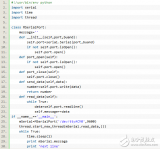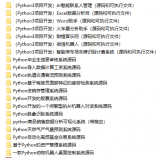將序列分解為單獨的變量
問題:現(xiàn)在有一個包含 N 個元素的元組或者是序列,怎樣將它里面的值解壓后同時賦值給 N 個變量?
解答:任何的序列(或者是可迭代對象)可以通過一個簡單的賦值操作來分解為單獨的變量。 唯一的要求就是變量的總數(shù)和結(jié)構(gòu)必須與序列相吻合。
代碼示例:(當前環(huán)境為python3.8版本)
1p = (1, 2)
2x, y = p
3
4x # 1
5y # 2
6
7data = [ 'ABC', 20, 51.1, (2023, 2, 5) ]
8name, age, price, date = data
9name # 'ABC'
10date # (2023, 2, 5)
解壓可迭代對象賦值給多個變量
問:如果一個可迭代對象的元素個數(shù)超過變量個數(shù)時,會拋出一個 ValueError。 那么怎樣才能從這個可迭代對象中解壓出 N 個元素出來?
解答:Python 的星號表達式可以用來解決這個問題。比如,你在學習一門課程,在學期末的時候, 你想統(tǒng)計下家庭作業(yè)的平均成績,但是排除掉第一個和最后一個分數(shù)。如果只有四個分數(shù),你可能就直接去簡單的手動賦值, 但如果有 24 個呢?這時候星號表達式就派上用場了。
1def drop_first_last(grades):
2 first, *middle, last = grades
3 return avg(middle)
另外一種情況,假設你現(xiàn)在有一些用戶的記錄列表,每條記錄包含一個名字、郵件,接著就是不確定數(shù)量的電話號碼。 你可以像下面這樣分解這些記錄:
1record = ('Dave', 'dave@example.com', '773-555-1212', '847-555-1212')
2name, email, *phone_numbers = record
3name # 'Dave'
4email # 'dave@example.com'
5phone_numbers # ['773-555-1212', '847-555-1212']
值得注意的是上面解壓出的 phone_numbers 變量永遠都是列表類型,不管解壓的電話號碼數(shù)量是多少(包括 0 個)。
查找最大或最小的 N 個元素
問題:怎樣從一個集合中獲得最大或者最小的 N 個元素列表?
解答:heapq 模塊有兩個函數(shù):nlargest() 和 nsmallest() 可以完美解決這個問題。
1import heapq
2nums = [1, 8, 2, 23, 7, -4, 18, 23, 42, 37, 2]
3print(heapq.nlargest(3, nums)) # Prints [42, 37, 23]
4print(heapq.nsmallest(3, nums)) # Prints [-4, 1, 2]
兩個函數(shù)都能接受一個關(guān)鍵字參數(shù),用于更復雜的數(shù)據(jù)結(jié)構(gòu)中:
1portfolio = [
2 {'name': 'IBM', 'shares': 100, 'price': 91.1},
3 {'name': 'AAPL', 'shares': 50, 'price': 543.22},
4 {'name': 'FB', 'shares': 200, 'price': 21.09},
5 {'name': 'HPQ', 'shares': 35, 'price': 31.75},
6 {'name': 'YHOO', 'shares': 45, 'price': 16.35},
7 {'name': 'ACME', 'shares': 75, 'price': 115.65}
8]
9cheap = heapq.nsmallest(3, portfolio, key=lambda s: s['price'])
10cheap
11# [{'name': 'YHOO', 'shares': 45, 'price': 16.35}, {'name': 'FB', 'shares': 200, 'price': 21.09},{'name': 'HPQ', 'shares': 35, 'price': 31.75}]
12expensive = heapq.nlargest(3, portfolio, key=lambda s: s['price'])
13expensive
14# [{'name': 'AAPL', 'shares': 50, 'price': 543.22},{'name': 'ACME', 'shares': 75, 'price': 115.65}, {'name': 'IBM', 'shares': 100, 'price': 91.1}]
字典的運算
問題:怎樣在數(shù)據(jù)字典中執(zhí)行一些計算操作(比如求最小值、最大值、排序等等)?
解答:考慮下面的股票名和價格映射字典
1prices = {
2 'ACME': 45.23,
3 'AAPL': 612.78,
4 'IBM': 205.55,
5 'HPQ': 37.20,
6 'FB': 10.75
7}
為了對字典值執(zhí)行計算操作,通常需要使用 zip() 函數(shù)先將鍵和值反轉(zhuǎn)過來。 比如,下面是查找最小和最大股票價格和股票值的代碼:
1min_price = min(zip(prices.values(), prices.keys()))
2# min_price is (10.75, 'FB')
3max_price = max(zip(prices.values(), prices.keys()))
4# max_price is (612.78, 'AAPL')
類似的,可以使用 zip() 和 sorted() 函數(shù)來排列字典數(shù)據(jù):
1prices_sorted = sorted(zip(prices.values(), prices.keys()))
2# prices_sorted is [(10.75, 'FB'), (37.2, 'HPQ'),
3# (45.23, 'ACME'), (205.55, 'IBM'),
4# (612.78, 'AAPL')]
執(zhí)行這些計算的時候,需要注意的是 zip() 函數(shù)創(chuàng)建的是一個只能訪問一次的迭代器。 比如,下面的代碼就會產(chǎn)生錯誤:
1prices_and_names = zip(prices.values(), prices.keys())
2print(min(prices_and_names)) # (10.75, 'FB')
3print(max(prices_and_names)) # ValueError: max() arg is an empty sequence
查找兩字典的相同點
問題:怎樣在兩個字典中尋找相同點(比如相同的鍵、相同的值等等)?
解答:考慮下面兩個字典
1a = {
2 'x' : 1,
3 'y' : 2,
4 'z' : 3
5}
6
7b = {
8 'w' : 10,
9 'x' : 11,
10 'y' : 2
11}
為了尋找兩個字典的相同點,可以簡單的在兩字典的 keys() 或者 items() 方法返回結(jié)果上執(zhí)行集合操作。比如:
1# Find keys in common
2a.keys() & b.keys() # { 'x', 'y' }
3# Find keys in a that are not in b
4a.keys() - b.keys() # { 'z' }
5# Find (key,value) pairs in common
6a.items() & b.items() # { ('y', 2) }
這些操作也可以用于修改或者過濾字典元素。 比如,假如你想以現(xiàn)有字典構(gòu)造一個排除幾個指定鍵的新字典。 下面利用字典推導來實現(xiàn)這樣的需求:
1# Make a new dictionary with certain keys removed
2c = {key:a[key] for key in a.keys() - {'z', 'w'}}
3# c is {'x': 1, 'y': 2}
序列中出現(xiàn)次數(shù)最多的元素
問題:怎樣找出一個序列中出現(xiàn)次數(shù)最多的元素呢?
解答:collections.Counter 類就是專門為這類問題而設計的, 它甚至有一個有用的 most_common() 方法直接給了你答案。
先假設你有一個單詞列表并且想找出哪個單詞出現(xiàn)頻率最高。你可以這樣做:
1words = [
2 'look', 'into', 'my', 'eyes', 'look', 'into', 'my', 'eyes',
3 'the', 'eyes', 'the', 'eyes', 'the', 'eyes', 'not', 'around', 'the',
4 'eyes', "don't", 'look', 'around', 'the', 'eyes', 'look', 'into',
5 'my', 'eyes', "you're", 'under'
6]
7from collections import Counter
8word_counts = Counter(words)
9# 出現(xiàn)頻率最高的3個單詞
10top_three = word_counts.most_common(3)
11print(top_three)
12# Outputs [('eyes', 8), ('the', 5), ('look', 4)]
通過某個字段將記錄分組
問題:你有一個字典或者實例的序列,然后你想根據(jù)某個特定的字段比如 date 來分組迭代訪問。
解答:itertools.groupby() 函數(shù)對于這樣的數(shù)據(jù)分組操作非常實用。 假設你已經(jīng)有了下列的字典列表:
1rows = [
2 {'address': '5412 N CLARK', 'date': '07/01/2012'},
3 {'address': '5148 N CLARK', 'date': '07/04/2012'},
4 {'address': '5800 E 58TH', 'date': '07/02/2012'},
5 {'address': '2122 N CLARK', 'date': '07/03/2012'},
6 {'address': '5645 N RAVENSWOOD', 'date': '07/02/2012'},
7 {'address': '1060 W ADDISON', 'date': '07/02/2012'},
8 {'address': '4801 N BROADWAY', 'date': '07/01/2012'},
9 {'address': '1039 W GRANVILLE', 'date': '07/04/2012'},
10]
現(xiàn)在假設你想在按 date 分組后的數(shù)據(jù)塊上進行迭代。為了這樣做,你首先需要按照指定的字段(這里就是date)排序, 然后調(diào)用 itertools.groupby() 函數(shù):
1from operator import itemgetter
2from itertools import groupby
3
4# Sort by the desired field first
5rows.sort(key=itemgetter('date'))
6# Iterate in groups
7for date, items in groupby(rows, key=itemgetter('date')):
8 print(date)
9 for i in items:
10 print(' ', i)
運行結(jié)果:
107/01/2012
2 {'date': '07/01/2012', 'address': '5412 N CLARK'}
3 {'date': '07/01/2012', 'address': '4801 N BROADWAY'}
407/02/2012
5 {'date': '07/02/2012', 'address': '5800 E 58TH'}
6 {'date': '07/02/2012', 'address': '5645 N RAVENSWOOD'}
7 {'date': '07/02/2012', 'address': '1060 W ADDISON'}
807/03/2012
9 {'date': '07/03/2012', 'address': '2122 N CLARK'}
1007/04/2012
11 {'date': '07/04/2012', 'address': '5148 N CLARK'}
12 {'date': '07/04/2012', 'address': '1039 W GRANVILLE'}
過濾序列元素
問題:你有一個數(shù)據(jù)序列,想利用一些規(guī)則從中提取出需要的值或者是縮短序列。
解答:最簡單的過濾序列元素的方法就是使用列表推導。比如:
1mylist = [1, 4, -5, 10, -7, 2, 3, -1]
2[n for n in mylist if n > 0]
3# [1, 4, 10, 2, 3]
4[n for n in mylist if n < 0]
5# [-5, -7, -1]
有時候,過濾規(guī)則比較復雜,不能簡單的在列表推導或者生成器表達式中表達出來。 比如,假設過濾的時候需要處理一些異常或者其他復雜情況。這時候你可以將過濾代碼放到一個函數(shù)中, 然后使用內(nèi)建的 filter() 函數(shù)。示例如下:
1values = ['1', '2', '-3', '-', '4', 'N/A', '5']
2def is_int(val):
3 try:
4 x = int(val)
5 return True
6 except ValueError:
7 return False
8ivals = list(filter(is_int, values))
9print(ivals)
10# Outputs ['1', '2', '-3', '4', '5']
filter() 函數(shù)創(chuàng)建了一個迭代器,因此如果你想得到一個列表的話,就得像示例那樣使用 list() 去轉(zhuǎn)換。
轉(zhuǎn)換并同時計算數(shù)據(jù)
問題:你需要在數(shù)據(jù)序列上執(zhí)行聚集函數(shù)(比如 sum() , min() , max()), 但是首先你需要先轉(zhuǎn)換或者過濾數(shù)據(jù)
解答:一個非常優(yōu)雅的方式去結(jié)合數(shù)據(jù)計算與轉(zhuǎn)換就是使用一個生成器表達式參數(shù)。 比如,如果你想計算平方和,可以像下面這樣做:
1nums = [1, 2, 3, 4, 5]
2s = sum(x * x for x in nums)
下面是更多的例子:
1# Determine if any .py files exist in a directory
2import os
3files = os.listdir('dirname')
4if any(name.endswith('.py') for name in files):
5 print('There be python!')
6else:
7 print('Sorry, no python.')
8# Output a tuple as CSV
9s = ('ACME', 50, 123.45)
10print(','.join(str(x) for x in s))
11# Data reduction across fields of a data structure
12portfolio = [
13 {'name':'GOOG', 'shares': 50},
14 {'name':'YHOO', 'shares': 75},
15 {'name':'AOL', 'shares': 20},
16 {'name':'SCOX', 'shares': 65}
17]
18min_shares = min(s['shares'] for s in portfolio)
合并多個字典或映射
問題:現(xiàn)在有多個字典或者映射,你想將它們從邏輯上合并為一個單一的映射后執(zhí)行某些操作, 比如查找值或者檢查某些鍵是否存在。
解答:假如你有如下兩個字典
1a = {'x': 1, 'z': 3 }
2b = {'y': 2, 'z': 4 }
現(xiàn)在假設你必須在兩個字典中執(zhí)行查找操作(比如先從 a 中找,如果找不到再在 b 中找)。 一個非常簡單的解決方案就是使用 collections 模塊中的 ChainMap 類。比如:
1from collections import ChainMap
2c = ChainMap(a,b)
3print(c['x']) # Outputs 1 (from a)
4print(c['y']) # Outputs 2 (from b)
5print(c['z']) # Outputs 3 (from a)
 電子發(fā)燒友App
電子發(fā)燒友App

























評論